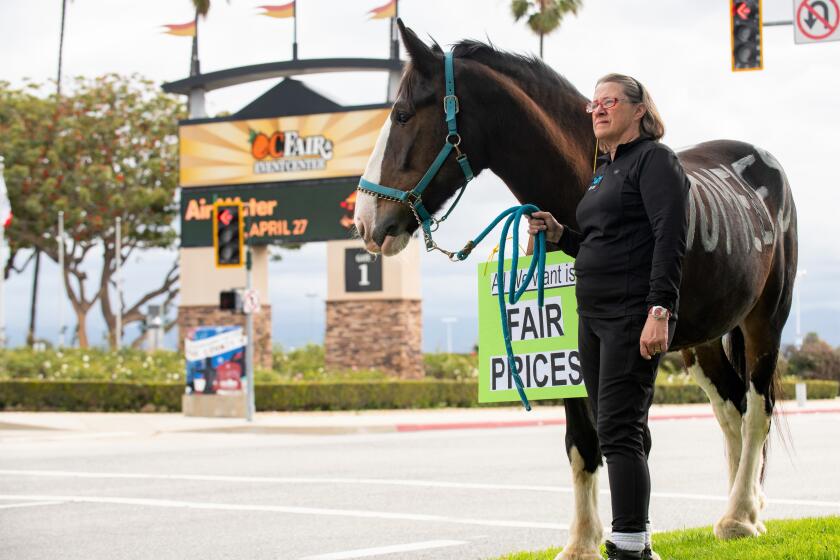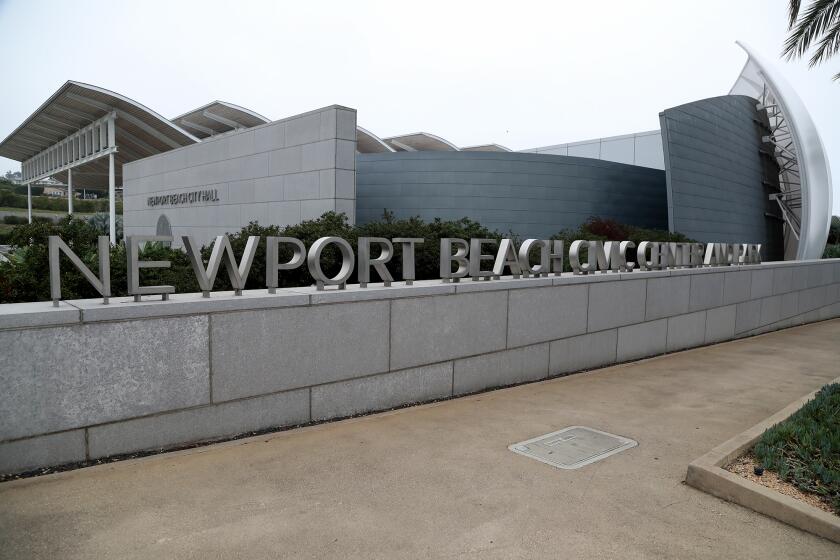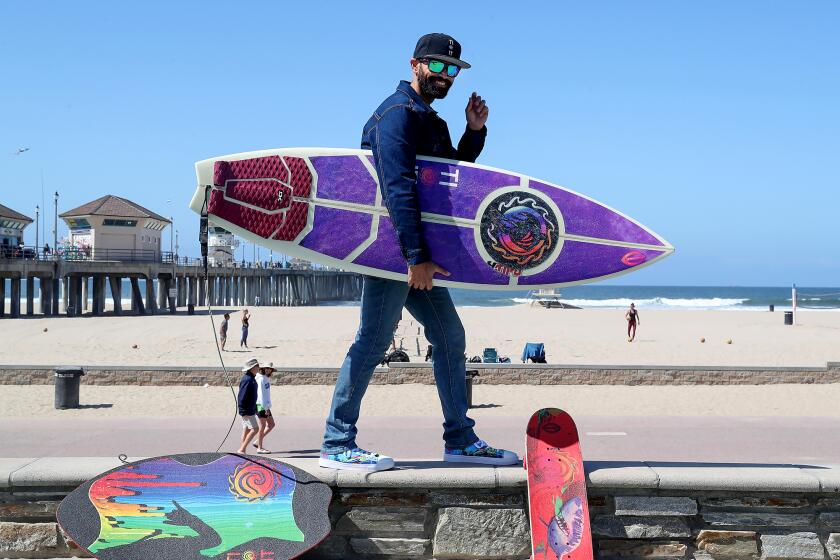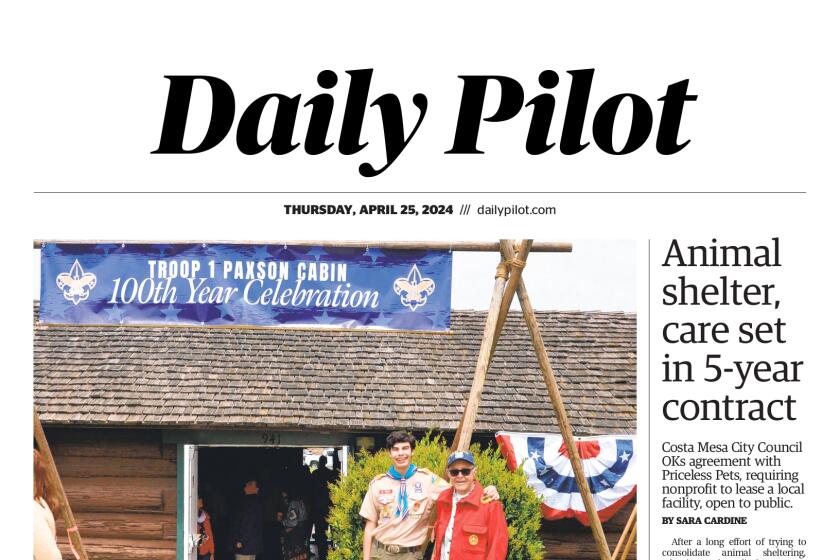One lap, one mile, one day
Small white bags flickering with light lined the inside curve of the track, guiding the procession of people around its dark loop.
The wail of a lone bagpipe player mingled with the sounds of two teens calling out name after name over a loudspeaker.
Holding a white candle ensconced in a clear plastic cup, Rick Nawrocki watched the flame as he moved slowly along with the throng of people.
Looking over his shoulder, he took in hundreds of faces illuminated by candles before whispering to his girlfriend, Sophie Shahnazi, to do the same.
At the Huntington Beach Relay for Life’s Luminaria Ceremony’s walk around the track, Nawrocki thought about the people whose lives intertwined with his when he was going from doctors’ offices to chemotherapy to radiation treatments.
“I think about some of the people I have met through the years,” Nawrocki said. “I know firsthand that some of them didn’t make it.”
An all-night walk
As the participants were slowly led by the bagpiper off the track and back to a stage, Miss Huntington Beaches 2008 and 2010 finished calling out the names inscribed onto the white bags, or luminaries, for those who died or are fighting cancer.
Residents bought 300 luminaries to stand sentinel through the night as residents walked and ran along the track.
The Relay for Life is the American Cancer Society’s signature event that brings the community together to raise money for cancer research, treatment and services, said Lori Couto, a senior Relay for Life manager.
Residents formed teams, which pledged to have at least one participant walking around Huntington Central Park from noon Saturday to noon Sunday.
The finals numbers aren’t in, but Couto said they did reach their $130,000 goal.
The day was filled with themed walks, from goofy hats and sunglasses to aprons, a bouncy obstacle course for kids and soccer playing dogs, while the Huntington Beach Firefighter’s Assn. spent Saturday manning a barbecue trailer, grilling up hot dogs, tri-tip steak, chicken and tacos.
Walking about the course, Nawrocki, a Torrance resident, blended in with the other walkers. In his black zip-up hoodie, shorts, running shoes and black visor, he gave off no indication that he is an ultramarathon runner.
With just a peak of purple, the designated color for cancer survivors, visible under his hoodie, residents could see he was one of few participants who had beaten the disease they were working to eradicate.
Nawrocki was diagnosed with non-hodgkin lymphoma cancer and had it come back five times before he was given a bone marrow transplant nine years ago.
It hasn’t come back and he said he isn’t worried about it returning, but Nawrocki continues running — the crutch that helped him get through cancer.
Running on empty
He was on the top of a peak in Death Valley in the middle of summer when he thought cancer might have finally slowed him down.
It was cooler on the peak, at least a couple of degrees below the 128 degrees it was at the bottom of the desert, but Nawrocki said he didn’t know if he was going to finish the race.
The pain was excruciating.
His hair was almost fully grown back, but his hamstrings weren’t completely healed yet.
Only five months earlier, he spent a month in the hospital after finally getting a bone marrow transplant. His doctor had told him it would take a year for his major muscles to fully heal, but he pushed himself anyway like he had been doing since he was diagnosed with cancer in 1996.
Between the doctor’s appointments, chemotherapy, radiation and experimental treatments, and changes to his body, running was the only thing Nawrocki said he had.
“That was the only thing I had control over, was my training,” he said.
‘Each day to the fullest’
At the top of that peak in Death Valley, Nawrocki was in the mist of the Bad Water Ultramarathon, a 135-mile invitation-only race from Death Valley to Mt. Whitney.
Just to compete in Bad Water healthy is a feat in itself, said Huntington Beach resident Mike Gallipeo, a Relay for Life volunteer who met Nawrocki through the event.
Nawrocki had already run Bad Water once, only months after being diagnosed, but came back again.
His brother was crewing him, but didn’t want to push him, thinking it could be too much. Still, Nawrocki got through the race like he got through his treatments — one at a time, mile after mile.
“I just feel so lucky that I was able to stay as healthy as I did,” he said.
He ran Bad Water one last time, but continues training regularly, running marathons on his own. He has slowly worked his way down to one doctor’s appointment a year and said he still takes it one day at a time.
“I just try to enjoy each day to the fullest,” he said.
With his girlfriend, he came back to Huntington Beach Relay for Life for the second year. Last year, he had run about 80 miles, but this year he was taking it easy — he only did about a marathon’s worth.
What Do You Think? Do you have any memories of participating in Relay for Life? Send us an e-mail at hbindependent @latimes.com or leave a comment on our website.
All the latest on Orange County from Orange County.
Get our free TimesOC newsletter.
You may occasionally receive promotional content from the Daily Pilot.



